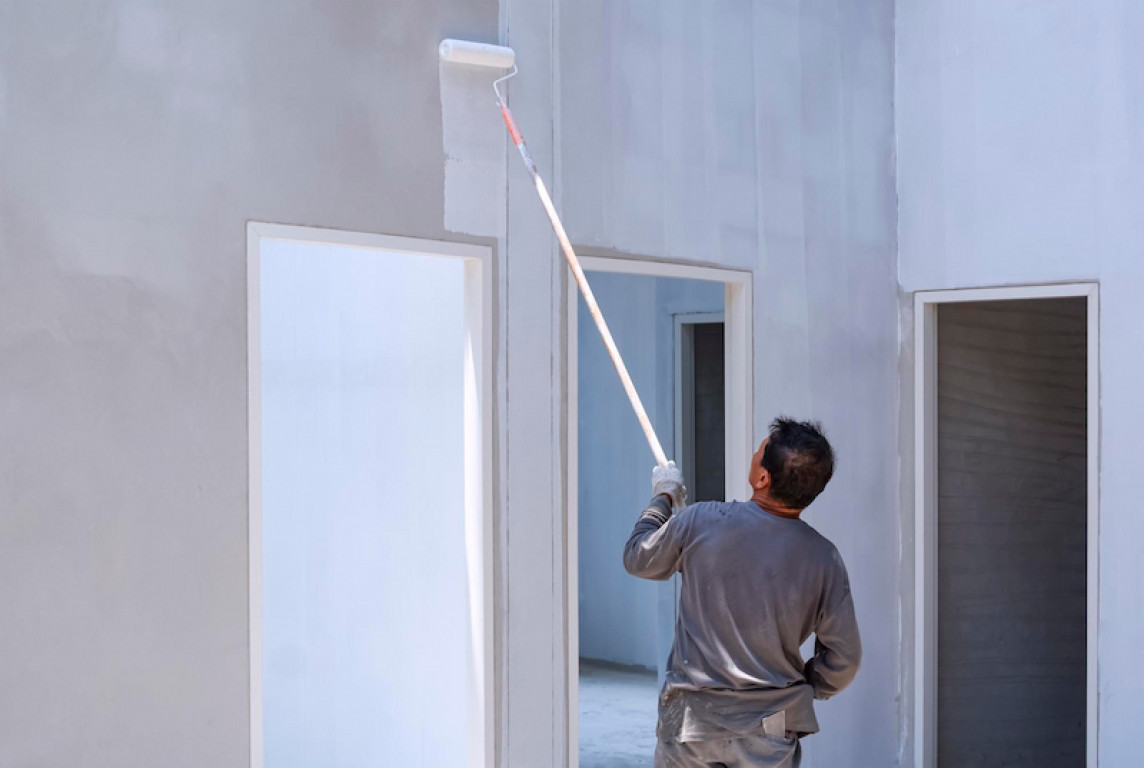Wall waterproofing coatings are available in various types, each with its own advantages and specific applications. These coatings can be used on both flat roofs and leaking walls, preventing continuous water infiltration from compromising the quality of your walls.
However, before applying these coatings, it is advisable to first investigate the underlying causes of the water seepage. There may be more serious issues, such as hairline cracks, that you are unaware of. You can inspect the surrounding area of the wall to identify the cause. Read this article further to learn more about this issue and tips for addressing leaking walls.
Various Types of Wall Waterproofing Coatings
There are several types of wall waterproofing coatings available in the market, each with its own advantages and disadvantages. You can choose one based on your needs and the location of the seepage. Below are some examples of waterproof coatings made from various materials:
1. Acrylic-Based Waterproofing Coating
The first type of waterproofing coating is acrylic-based. Acrylic waterproofing coatings are flexible, making them effective at covering small cracks that often serve as entry points for water. Additionally, these coatings are easy to apply on various surfaces, including interior and exterior walls. Another advantage is their durability against weather changes.
Acrylic coatings are also available in various colors, so they not only protect but also enhance the appearance of your home. Due to their environmentally friendly properties, these materials are ideal for residential areas. When applied correctly, acrylic coatings can last for years without requiring special maintenance.
2. Bitumen-Based Waterproofing Coating
The next type of waterproofing coating is bitumen-based. Bitumen is known for its resistance to water and moisture, making it a popular choice for areas of the home that come into direct contact with water, such as foundations, roofs, and exterior walls. The waterproofing properties of bitumen are highly effective in preventing water infiltration.
Although it is highly effective, bitumen-based coatings have a distinctive texture and odor, so they require careful application. This material is better suited for large-scale construction projects or specific areas rather than the entire house. With minimal maintenance, bitumen coatings can provide long-term protection for your home.
3. Epoxy-Based Waterproofing Coating
The final type of waterproofing coating is epoxy-based. Epoxy is a high-strength and highly durable waterproofing material. It is often selected for areas that require extra protection, such as garages, basements, or warehouses.
Another advantage of this coating is its strong adhesive properties, making it suitable for application on various types of surfaces. However, the epoxy application process requires specialized skills to ensure a perfect result. Due to its robust and long-lasting nature, epoxy tends to be more expensive compared to other types of coatings.
Tips to Prevent Water Seepage in Walls
To prevent water seepage in walls, regularly check the drainage system in your home. Acrylic-based wall coatings are among the most commonly used due to their water-resistant and flexible properties. This coating can cover small cracks in the wall and provide extra protection against rainwater.
1. Choose High-Quality Cement
Ensure that you use the best quality cement when constructing walls. High-quality cement offers better adhesion and strength, helping to prevent water from seeping into the walls. For this purpose, Semen Merah Putih Watershield is an ideal option.
2. Ensure Your Home's Drainage System is Functioning Well
Clogged or damaged drainage channels can lead to water pooling around the house, potentially seeping into the walls. Regularly check and clean your drainage system to ensure it remains fully functional.
Read also: What Is Grouting? Understanding Benefits and Types
3. Use High-Quality Exterior Paint
You can also address seepage by using superior exterior paint. High-quality exterior paints usually have water-resistant properties and are durable against weather changes. Choose a paint specifically formulated to protect exterior walls from water seepage.
4. Identify and Repair Cracks in the Walls
Small cracks in the walls can serve as entry points for water. Therefore, perform regular inspections and promptly repair any cracks using plaster or waterproofing coatings. You can use one of the previously mentioned waterproofing materials.
5. Use Lightweight Bricks
Lightweight bricks are more water-resistant compared to red bricks or concrete blocks. Additionally, lightweight bricks have excellent insulation properties, helping to maintain the room's humidity levels.
6. Build a Canopy or Install an Overhang
A canopy or overhang above windows and doors can help protect the walls from direct rain exposure. This seemingly simple solution is highly effective in safeguarding the walls during the rainy season.
7. Keep Walls Clean
One way to prevent water seepage in walls is by keeping the walls clean. Dust, dirt, or moss that accumulates on the walls can absorb water and worsen the seepage condition. Clean the walls regularly to avoid this issue.
Read also: How to Deal with Damp Walls? 7 Tips You Should Try!
Thus, the explanation above covers various types of waterproof coatings for walls and tips to address wall seepage issues. Before making any repairs, it’s advisable to check your home’s drainage system and the cleanliness of the walls. This way, you can identify the root cause of the water seepage.
Leaking walls should not be left unaddressed, as they may indicate more serious cracks that you are unaware of. If you have free time, it’s best to resolve this issue immediately. You can use construction materials that are specifically designed to resist water seepage. For this, consider using Semen Merah Putih Watershield.
Semen Merah Putih Watershield is a high-quality, flexible cement suitable for various needs, such as plastering, stucco work, concrete slabs, and mortar. It is ideal for construction areas that require additional strength and protection.
Semen Merah Putih Watershield is equipped with water-repellent technology that enhances building durability with triple protection against water seepage from inside, outside, and underground. This ensures your home is more durable, requires minimal maintenance, and is strong.
Are you working on a construction project? Choose quality cement for the best results! Use Semen Merah Putih Watershield for your home construction and renovation needs. Contact us for more information and make your concrete slab construction stronger and well-protected.
Read also: Precast Concrete: Definition, Functions, and Types



